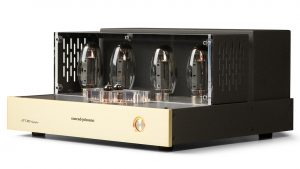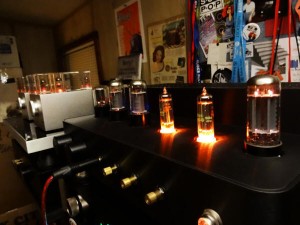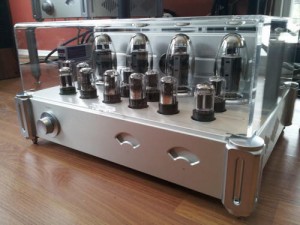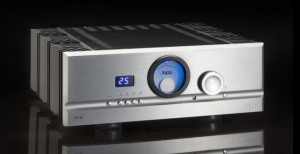
(Including an interview with Thomas Gessler, CEO of Audionet)
What's that? Things formerly unheard are stirring down below...

Some time ago I purchased the Shostakovich Cello Concerto No. 2 (Channel Classics CCS SA 25308, SACD). Less well-known, the second concerto is not programmed or recorded as often as his first, perhaps because the opening Largo contains long sections of dense, lower-register scoring, difficult stuff to parse. Factor in that most home audio systems are challenged in those frequencies, you can understand how this first movement lends itself to daydreaming, to which I succumbed until awakened by a couple of rude, high-impact tympani thwacks towards the close. I never got past the first movement and quickly filed the disc.
Recently, while reorganizing my CD storage, I rediscovered the disc and popped it into the drive. Skipping the slumberous first movement, I and went right to the second, also marked Largo. Now the rude tympani crashes came early and repeatedly, erupting about two minutes in. Then the piece takes off on one of those trademark Shostakovich roller coasters of dissonance and odd instrument pairings, exactly the sort of material that endears him to me. Of course, playback has the benefits of demonstration-class Channel Classics SACD sound, not to mention Pieter Wispelway as soloist. The vast dynamic range will certainly challenge your system.
And then… when those big tympani transients rolled out, I heard a crunching sound—the dreaded gasps of a system choking. I glanced over at the majestic Ypsilon Aelius Monoblocks I had in for review. Then my thoughts circled back to the SACD. I didn't want to believe the transient hiccup was related to the amps.

Soon after, I took delivery of the top-of-the-line Audionet MAX monoblock amplifiers. In due course, I returned to the Shostakovich SACD. This time when I hit Play, keenly focusing on those tympani transients as the two-minute marker approached, the tympani exploded with a force that literally stunned those present… and it was clean and distortion free!
I will never forget it. The fresh perspective offered by the Audionet MAX demonstrated that the 200 watt Ypsilon Aelius Monos were stressing out under this extreme transient demand. This occurred at a decision point: They are lovely amps and I was considering them for purchase. But the undeniable choking told me they were not a good match for my speakers. There's no way to know this until you put it to the test.
There is another lesson to be learned here: if you have any inkling of unplumbed goodness in an LP or CD, don't be too hasty to dismiss it. Best to give it the benefit of the doubt, for who knows, when that new turntable or DAC comes in, you might put it on and say, OMG!
Subsequent research revealed this Channel Classics Shostakovich SACD garnered top ratings for both sound and performance from BBC Music Magazine.

"Snap-Crackle-Pop" Dynamics
With the Audionet MAX powering the system, the stage was jumping. This top-flight dynamic prowess is only available from the peak offerings of brands like Soulution, Tenor, or CH Precision. At first you might think, "Wow, this dynamic vitality is really something, but is it too much?" That's because you've probably not heard such "Snap-Crackle-Pop" dynamics in a home environment before. The extremely wide dynamic range and straight-edged transient took some getting used to, particularly the potent, tightly controlled and generous energy of bass frequencies. But acclimation is quick such that if you were to swap the amps out you'd be wondering, "Where the heck did all the vitality go?" (For the record, the same eye-opening jolt comes with the Audionet PRE G2 Preamp I'm auditioning.)
The Family Resemblance
I tasted this vitality when I reviewed the one-step-down Audionet AMP monoblocks. Here is what I said about them:
"Full orchestral blasts exert maximum pugilistic verve. Abetting the impact is a dark-hued tonal balance that doesn't skimp on the lower frequencies and packs oodles of weight and heft."
"… [The AMP's transient] hits hard, with blazing speed and a sharp edge. Audionet gear refuses to slow it down. Indeed, with one of the highest slew rates in the industry, the specs clearly reflect what I am hearing."
Only now, with twice the thrust coefficient, the MAX attains higher orbit. Power ramps up from the AMP's 200 to 400 watts/8 ohms. Yet, for all that wallop, there is no trace of harshness anywhere—the proverbial iron fist in a silk glove. Rather than strident hi-fi highs, the MAX offers a low-noise, realistic treble. At twice the power, it's even smoother than the AMP monos! Perhaps there is a miniscule rounding up there that enables the purging of harshness?

The Family Difference
And it's not just the big swings. At the other end, returning to those previously indistinct stirrings down below in the first movement of the cello concerto, abundant signs of life appeared. The formerly cloudy sounds within that miasma began to make sense.
This was not a case of simply up-scaling the AMP monos. The MAX impart important refinements in the delivery. Images grew closer to life-size, gaining conspicuous bulk, while being somehow both crisply defined yet less etched. A wholly new roundness, normally the province of tube amps, was introduced, allowing you to sense the images in the round. Soundstage layering became easier to "see."
These differences coalesced into a lux presentation with more credibility—like that of the top amplifier models I mentioned earlier.
Soundstage Contrasts
Coming on the heels of the Ypsilon Aelius, there was a distinct difference in how each amp formed its soundstage.
The Aelius was notable for its remarkably well-behaved soundstage. It formed at the speakers, receded from that point, and did not budge. Regardless of the musical content or SPL, the front line did not advance forward from the plane of the speakers. It was soft and a bit laid back. Thus the Aelius ensured it would never sound harsh or abrasive. It did not POP. This mimics how sound behaves when you're seated at some remove in large spaces, such as rear parquet (orchestra) or first tier at Carnegie Hall—an ideal setting for classical music listening.

Similar to the Ypsilon, the MAX soundstage started at the speakers and receded from that point, but you are closer to the action: the perspective is more mid-parquet at Carnegie. The MAX is very alive and active, with soloists projecting forward into the room. The exciting "Snap-Crackle-Pop" dynamics of the MAX would never be described as soft and laid back.

Time for another demo. To show off the MAX's resolving power, let's listen to I Just Dropped by to Say Hello, the famous Johnny Hartman date accompanied by a stellar rhythm section. (My CD is a souped up, 20 bit, K2 encoded, Japanese HQCD.)
There is a very brief distortion byproduct just as Johnny enters at the beginning of Track 2. Through the MAX, I have no trouble isolating the problem. You might say the distortion forms its own discrete image, as if it were an instrument. It is definitely extra-musical, some kind of analog tape issue. Johnny sounds smooth as silk and the instruments are fine. Those who are interested in this level of intense scrutiny will find the MAX a powerful tool.
Cosmetics and Installation
The big brother in the Audionet amplifier line bears a strong cosmetic resemblance to the AMP. The footprint is shared in the length and narrow width, but the MAX stand half again as tall, and weight scales from 48 to 83 lbs. Still, this is not a big chassis for the level of power it puts out. The visual is clean lines and purposeful construction, not luxurious or overbuilt, just solid and well-made. The German aluminum faceplate with black accents is the Euro-look of the moment, as is the graphic display window that tells you about input selection and other pertinent info. Chassis interiors utilize amorphous granite, steel, aluminum and MDF. Parts quality, always a consideration for Audionet, is of the highest obtainable.

Installation was a piece of cake. Place them on the optional amp stands supplied by GTT (I used both those and my TAOC stands) and plug them directly into the wall. Avoid active conditioning. They accept single-ended or balanced inputs, selectable from the front-panel set up menu. Two sets of binding posts make biwiring very easy. I used Kubala•Sosna Elation! XLR interconnects, speaker wire and power cords to excellent effect. No re-voicing or tweaking of the system was necessary.
To start up, briefly push the front-panel button. A "Welcome" message displays. Holding down the button longer will bring you to the menu system. To shut down, again briefly push the front-panel button. A "Discharging" message appears. This message shows for about a minute before the window changes to "Good Bye," then goes dark. The MAX get warm to the touch, so give them room to breathe.

MAX Features and More Specs
The MAX pushes many of the AMP's already outstanding specs into new territory:
-Filtering capacity increases from 82,000 to 156,000 uF.
-Frequency response of DC to 300 now goes from DC up to 500K.
-SNR of 122 is now 125dB. Three dB constitute a huge difference.
-Damping factor is 1,800 at 10 kHz, 10,000 at 100 Hz. This means great bass control.
Other features are described on the website:
-The MAX utilize Audionet's acclaimed ULA (Ultra-Linear-Amplifier) technology. Originally invented for medical engineering purposes, it dramatically lowers the incidence of signal impurity even under conditions of maximum strain.
-Each monoblock contains a microprocessor unit that controls all functions and monitors fault conditions such as DC leakage, high frequency issues, over-heating temperature and overload. If a fault is detected, it disconnects the MAX from the mains supply and a message is displayed on the front window.
Conclusion
The top-of-the-line MAX Mono Amplifier from Audionet reminded me of their smaller brother, the AMP monos, which I reviewed earlier. There is a strong family resemblance in the cosmetics and features. But the resemblance pales when it comes to performance: the MAX do more than merely double up the wattage per channel. They put you on a new playing field.
Beyond a dynamic range and thrust power that is the envy of the competition—dynamic prowess doesn't get any better than this—the MAX amps plumb the hidden depths of your favorite CDs and LPs. With the MAX you experience refinements offered only by the top models from the major players. The MAX join a very select group of top-tier components, but the MAX get you there for a fraction of the price. I'm not saying they're cheap, but they do meet the definition of a bargain.
Nit-pickers will look high and low in vain, because the MAX do everything right. I have found my next reference. Yes, the MAX will replace the Soulution 710 Stereo Amplifier in Nack Labs. They are that good.
Specifications:
MAX Mono power amplifier $30,500/pair
Audionet
en.audionet.de
Distributor
GTT Audio/Video
908-850-3092
[email protected]
www.gttaudio.com

An Interview with Thomas Gessler, CEO of Audionet
PFO - Audionet has 19 years in the consumer High End Audio business. How well-known is the brand in Germany/Europe?
TG - Over the years in Europe we got so many awards, recommendations, reviews, public attention and of course sales, I think it's safe to assume everyone who is interested in high performance audio knows us.
How large is the factory? How many employees?
Our factory is approximately1000 square meters and we employ a team of 20.
Audionet is new to the USA. What has changed to make you look for new markets?
When we started our focus were of course Germany and Europe but also our market exploded in Asia.
These markets in addition to our scientific research and development work absorbed our full concentration. Recently we made a decision to break new ground. The USA is our strategic starting point.
Looking at Audionet product lines, there are some close family resemblances in the cosmetic and functional areas. Do the resemblances extend to the design/engineering side?
Audionet is a spinoff of the electronic department of the Ruhr-Universität Bochum. At that time we did research in new analog amplification technologies for measurement systems and in digital signal processing. The basic approach to work, the basic technical concepts and engineering guidelines have been acquired from these R&D activities and constantly further developed. They are the same for all our products.
In product evaluation, do you rely on measurement or subjective listening?
It is like in any high performance and high tech field. First you need sophisticated ideas and thorough engineering, then the passion and experience to bring it to the best performance. For a F1 racing car, the driver´s feeling on the racecourse decides the final tuning.
We do it the same way. First, the electronic concept must be right. That can only be determined by measurement. In this objective view, a MAX is with the absolute best existing. In general, I would describe our technology as being state of the art, of what is possible today.
A crazy fact is, the more neutral an audio circuit operates, the more you can hear the smallest changes. Therefore, for many years, we took great care to not only look into the sound characteristics of components, but also into the sound properties of materials. We use silver, gold, rhodium in our designs, not because these materials are cool or posh, but because used in the right way, they improve the sound potential. We spend much of our time with the sound tuning of our devices. I describe Audionet today also as a creative, even artistic project! However, best measurement results are the basic requirement.
Here is another important point: This requires a listening environment that makes it possible at all to evaluate the sound characteristics. Therefore, we have invested a lot of money and of our time into our listening laboratory, which surely is one of the most sophisticated and neutral auditioning rooms in the industry. Here we can listen unequivocally to what we are engineering and measuring.
Link: http://www.av-magazin.de/Der_optimierte_Hoerraum_von_Au.2929.0.html
(This article in in German but you can see some photos.)
What are the particular sonic qualities you strive for?
The goal is neutrality. We want information, you may call it resolution. What we are doing is to provide as much information as possible without highlighting any one or multiple frequencies... If you do it properly, the information contains all, what music is: rhythm, sound colours, dynamics, light, soundstage, darkness, enlightenment, emotion!
How do your products differ from your competitors?
Again, to be quite honest, I do not know. I do not and would not judge others. I only can describe what we are doing. It could be that we focus more on the engineering, others more on marketing.
What do you see as the future direction of the High End?
I do not know anyone who is untouched by music. And there are a growing number of people, who really enjoy the very large emotional experience with music. Our target group is growing.
Topics of the near and mid future will be the same like today: the supply of digital sourceswill further differentiate: providers, formats, resolutions, access channels, prices. Of course high res will be important in the future. Vinyl and turntables will continue to get attention. I see potential to improve amplification technology and signal processing for audio applications.
Thank you, Thomas.













































